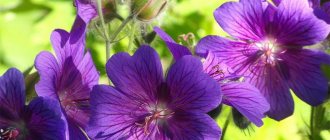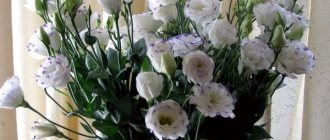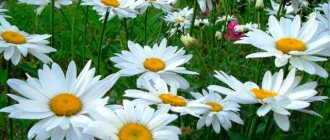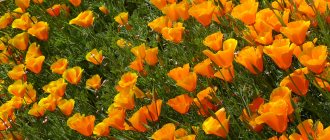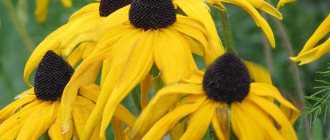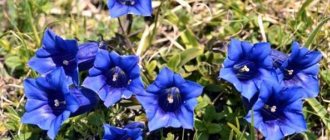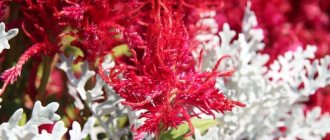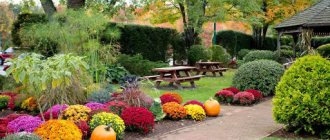This is one of the most popular garden plants with universal uses. Geranium is great as a houseplant and garden plant, even as a ground cover. It looks great in modern gardens. Some species readily grow in the sun, others in the shade. Let's find out how perennial garden geranium is grown - planting and care in open ground, look at photos of species and varieties, find out how to provide the plant so that it decorates the garden all season long.
Description of the plant
Geranium (Geranium L.) is a genus of perennial or annual plants from the geranium family. The genus contains approximately 300-450 species. These include annuals, perennials, and less commonly subshrubs and shrubs. They are found on almost all continents; in the tropical zone they grow in the mountains. The greatest diversity is found in the temperate climate zone. There are about 40 species in Russia, some are also cultivated as ornamental plants.
Geranium or crane flower has a special charm. It is hardy to various conditions and grows easily. However, different types of geranium have different requirements that must be taken into account when growing. There are varieties for shady, semi-shaded and sunny areas, low, medium and tall, varieties that fit beautifully into flower beds, and those that will decorate rocky gardens and a forested corner of the garden. Neither species will require much effort other than choosing the right planting site and providing basic growing conditions.
Geranium has several hundred species and grows on most continents. In our area you can find more than a dozen varieties, some of them are grown as ornamental plants. Several species can also be planted in gardens.
Geranium (Geranium) is quite closely related to pelargonium, although it does not bloom as grandly, but you can see the similarities in the shape of the leaves and flowers. In English and German, pelargonium is usually called geranium (that is, the botanical name for geranium). Once these plants belonged to the same species, but then they separated.
The name geranium comes from the Greek word geranos or γερανός, meaning crane, because the geranium fruit is associated with the beak of a crane. The English colloquial name for the plant is cranesbill.
Botanical characteristics:
- Leaves. Solitary, dissected, often lobed, rarely pinnate, collected in a rosette, stem, usually opposite, with stipules. Leaves on distinct petioles. The leaves of some species turn beautiful orange and red in autumn.
- Flowers – have different sizes, but always consist of 5 petals. Rarely grow singly, more often in pairs from leaf axils or at the apex, forming a complex apical inflorescence. The sepals overlap each other, blunt or long, pointed at the top. At the center of the flower is a spectacular pistil surrounded by ten stamens. The filaments of the stamens are often expanded and pubescent at the base. Petals come in different colors. The flowers grow on stalks and are usually very numerous, which compensates for their delicate appearance.
- Fruit. They contain 5 individual seeds and are shaped like a crane's beak. When ripe, they burst and fly away. The special hooks they are equipped with can be attached to animal fur.
Varieties with colorful and patterned leaves are becoming more popular.
The form of a geranium bush is:
- crested – species Geranium cantabrigiense, Geranium himalayense;
- flat spherical – species Geranium macrorrhizum, Geranium sanguineum;
- cushion-shaped – Geranium endressii, Geranium dalmaticum.
In autumn, plants take on different colors:
- red – for example, Geranium pratense variety “Midnight Reiter”, Geranium sanguineum variety “Max Frei” Max Frei;
- orange – Geranium macrorrhizum variety “Pindus” Pindus;
- yellow – Geranium oxonianum variety “Johnson”, Geranium renardii;
- do not lose color – Geranium pratense variety “Silver Queen”, Geranium himalayense variety “Irish Blue” Irish Blue.
Landing
Garden geranium is an easy-to-grow perennial that quickly adapts to different living conditions. Tolerates different types of soil well, except wet and rocky.
Choosing a planting site, soil requirements
These perennials can be planted in almost any corner of the garden. Some species love the sun. Some species - Geranium macrorrhizum, Geranium phaeum - can withstand shade without problems, but the more shade, the less they bloom. We provide this information when describing individual species below.
Geranium can grow in a variety of soils, but does not like wetlands. Grows well even on poorly fertile sandy soil.
Most of all, geranium loves soils:
- fertile;
- permeable, well drained;
- with a slightly alkaline or neutral pH level;
- some species love soils with a high calcium content - blood red, Renarda, Dalmatian, Endrisa
Landing
Geranium seedlings can be purchased at a garden store. They are bought in containers, which makes them take root faster. Geraniums are planted in open ground when warm weather sets in - in May.
Depending on the type, geraniums are planted according to different schemes; on average, 8-14 plants are planted per 1 m² - in this density they look most beautiful.
Before planting, dig up the area; you can add compost during the digging, especially on weak soils. You need to select all the weeds and level the area.
Blood red geraniums should be placed quite tightly next to each other. The optimal interval is 10 pieces per 1 square meter. It grows quickly, but cuttings bought in stores or divided are quite small, so they can be planted very densely.
How to plant geraniums correctly
Perennial garden geranium quickly develops long roots. Allow the young shoots to take root well and grow undisturbed for the first time: dig a deep hole so that about 20 cm of loose soil remains under the longest root. There should be at least 30 cm between the holes. Before planting, treat the rhizomes with a disinfectant solution and the lower sections of the cuttings with growth stimulants.
Planting is carried out in early spring or autumn. Place a mound of fertile soil at the bottom, install the rhizome and distribute the underground shoots evenly over the soil elevation. Cover with soil and water to compact the soil. The first year there will not be very many leaves; they will not protect the flower garden from weeds. To avoid weeding, mulch the soil. Pelargonium, asters or other annuals can fill the voids.
Bury the cut cuttings into the soil by about 5 cm. Until the shoots take root, they require care. Protect the sprouts from frost with film or non-woven material. Make sure the soil is moist, but the water does not stagnate. In hot weather, all plantings in the first days should be shaded from the scorching rays of the sun.
Growing and care
Garden geranium is one of the most undemanding plants and is suitable even for beginner gardeners and does not require special care. It tolerates drought and frost quite well. The species is highly resistant to pests and fungal diseases.
Watering, fertilizing
Different species have slightly different soil moisture requirements.
On light soils, geranium can be fed by choice:
- organic fertilizer (compost);
- mineral fertilizer for flowering plants with a high content of phosphorus and microelements, so that it blooms better (this is especially important for large species).
For example, the blood-red and large-rhizoma species tolerate a lack of water well, so you don’t have to worry about watering them. They tolerate drought much better than stagnant water, so you should limit watering in shady areas and ensure drainage. They thrive on less fertile soils, so fertilizers are also not needed. These are ideal species for beginner gardeners and people with little experience caring for plants.
Trimming
It is worth remembering to remove faded inflorescences. This makes the plants more beautiful and prevents the bushes from sowing ripe seeds.
When the geranium has faded, it is worth pruning it - the shoots are cut to half their height (about 15 cm above the ground), soon the plants will be covered with young leaves and new flowers. This pruning is especially recommended for lush species. The easiest way to trim plants over a larger area is to use a hedge trimmer. After feeding with fertilizers, some species, such as meadow and forest geraniums, will bloom a second time on new shoots.
Late fall pruning is not recommended, especially for evergreen species.
Wintering
Most types of geranium are frost-resistant. Red, large-rhizome species and many others do not need shelter - they feel good under the snow.
Diseases and pests
In wet weather, the plant can be affected by fungal and bacterial diseases. It is necessary to immediately remove diseased leaves, preventing the spread of infection, and treat the plant with a fungicide according to the instructions.
Fungal diseases affecting geranium:
- Downy mildew (Plasmopara geranii) - brownish-purple spots are visible on the upper side of the leaf, a whitish coating appears on the lower side, where the spots are present. Leaves die at the site of infection.
- Leaf spot (Cercospora geranii, Phyllosticta geranii, Ramularia geranii, Septoria expansa).
- Rust (Puccini spp.)
Bacterial diseases affecting geranium:
- Bacterial leaf spot (Pseudomonas erodii) – small yellow-brown spots are visible on the leaves, which increase in size and turn brown over time. A yellow frame appears along their edges. Infected leaves die.
Geranium is affected by some pests:
- Chrysanthemum nematode (Aphelenchoides ritzemabosi) - dark brown spots appear on the leaves, limited by veins.
- Spider mite (Tetranyus urticae) – yellowish or reddish-purple discoloration appears on the leaves.
- The sawfly (Protemphytus carpini) is a hymenopteran insect whose larvae gnaw holes in the leaves.
Reproduction
Most types of geranium are propagated by seeds or by dividing bushes. Some species with extensive roots, for example, ash geranium, blood red geranium, can be propagated by root cuttings.
By division
Geraniums are easier to propagate by division. It needs to be dug up and divided (or using a sharp shovel to separate a part without digging up the whole thing). The plant has strong, long roots, so they can be seriously damaged during digging. Fortunately, the roots are easily restored and the seedling takes root. Geraniums are propagated by division in the spring - from April to the end of May.
Seeds
Geranium can be propagated by sowing seeds, but this is quite labor-intensive (the seeds take a long time to grow and germinate poorly). Before sowing, seeds need to be stratified (cooled) in the refrigerator.
Seeds can be prepared in the summer by collecting the fruits and drying them in the shade. This must be done carefully; ripe fruits burst in your hands, and the seeds scatter in all directions.
Quite often, geraniums spread themselves - the plant literally shoots seeds. This will not be a nuisance, but if we want to prevent uncontrolled spread, it is better to prune the flowers before the seeds begin to ripen.
Watering flowers
Pelargonium, unlike other flower crops, requires special watering, which is preferably done in the morning. Due to this, the plant will receive a sufficient amount of moisture for the whole day and will avoid root rotting.
Advice! It should be moistened generously, but so that the liquid does not touch the leaves. If the foliage is constantly exposed to moisture, they may wilt, and the plant may then die altogether.
Use in landscape design
Geraniums can be planted in compositions with other flowers, or in groups of the same species. For geraniums to look beautiful, there must be at least several plants. A lone bush will not look impressive. These plants grow well and can be used for turfing, for example, Cantabrian, Himalayan, ash geranium.
The roots and aerial parts of geranium contain a significant amount of essential oils, which act as a repellent for mosquitoes, moths, and slugs.
Because this plant is quite extensive, it is ideal for large surfaces. Tall varieties look good in flower beds.
Low ones are used as cover plants, replacing lawns, grow well under the canopy of trees and shrubs, and are suitable for flower meadows and rock gardens. Low species: blood red (20-40 cm), Himalayan (30-40 cm) are often planted in flower beds and rock gardens. Geranium tolerates competition well, so it is worth planting it between shrubs and tall perennials.
Large-rhizome geranium, undemanding to soil, can be grown in country houses and in city parks, where the soil is poor and care is poor.
Himalayan geranium can be combined with tulips and hyacinths, as it produces leaves earlier.
Geranium goes well with:
- peonies,
- irises,
- tulips,
- catnip,
- lupine,
- bells,
- foxglove,
- herbs,
- decorative garlic,
- other natural perennials.
Preparation of planting material
Before transplanting seedlings or geranium cuttings into the soil, the seedlings will need to be hardened off approximately seven days before. Every day you will need to take the planting material outside to the area where you plan to plant the plants, or you can artificially create conditions that will be in the country.
Pots or other containers with seedlings can be left overnight if the temperature outside does not drop below zero around the clock.
Thanks to hardening, planted flowers adapt better and faster to new conditions. In this way, you can achieve high and lush flowering throughout the summer season.
Popular types and varieties
Geranium includes more than 400 species, of which about 40 grow in Russia, but only a few are the most common. Types differ in appearance, size, and requirements.
Blood red
In Russia, blood-red geranium (Geranium sanguineum) grows in the wild. This is one of the most beautiful wild plants growing in forests. The species is also grown as an ornamental plant. Grows up to 25-40 cm in height, forms beautiful dense bushes. The species, refined by breeders and geneticists, has now become one of the most popular ground cover plants. To get a really thick carpet of flowers, the plants need to be planted quite densely. It only grows in the sun. The soil should be dry and well drained.
The names "red" or "blood red" can be misleading. The flowers of this species are not red, they are often bright pink, even purple.
Interesting varieties:
- Popular variety "Max Frey" Max Frei - flowers are slightly purple, a low-growing plant, ideal for creating borders and rocky gardens.
- “Album” Album – with white flowers, slightly taller.
- “Elke” Elke – has a slightly pink color, delicate, like “Alba”.
- "Lankastriense" Lancastriense - with light pink flowers.
Blooms profusely in early summer, then blooms less profusely until September. The species is completely frost-resistant, can grow in the sun and in light shade; decorative varieties prefer the sun. In autumn the leaves turn a beautiful red color. Has low requirements for conditions.
Large rhizomatous
Large-rhizome geranium (Geranium macrorrhizum) can be used as a sod plant and grows well. This is a low species (height - 30 cm), but spreading. Has a pleasant smell (used for the production of essential oils). The leaves are partly evergreen. The flowers are pinkish-red, with characteristic long stamens. There are varieties with white flowers (White Ness). Blooms from May to June/July. The species loves sun and partial shade and copes with shade. Large roots allow it to survive drought.
The species is planted in flower beds, the edges of rock gardens, between trees and shrubs.
Lugovaya
Tall meadow geranium (Geranium pratense) is quite majestic, grows up to 50-80 cm. Until recently, it was an ordinary meadow plant. Today more common in gardens, its delicate blue flowers decorate flower beds from June to September.
It has rather large purple-blue flowers with light veins on the petals. There are varieties with double flowers (“Plenum Volaceum” Plenum Volaceum). Likes slightly moister soil than other geraniums, but does not like standing water in the soil. Grows well in partial shade. Grows in the wild, the plant has been used in folk medicine.
Some varieties:
- "Midnight Reiter" Midnight Reiter - purple-blue;
- “Plenum Violaceum” Plenum Violaceum – violet-blue;
- “Silver Queen” Silver Queen – pale purple;
- "Victor Reiter" Victor Reiter - purple-blue.
Gorgeous
Another tall species is the magnificent geranium (Geranium × magnificum). Not found in the natural environment - it is a hybrid created by botanists by crossing Geranium platypetalum and Geranium ibericum. An exceptionally majestic plant - grows up to 40-70 cm. It has a spherical, bushy shape. The leaves turn yellow, orange, and red in the fall.
It has large flowers with a diameter of 5 cm with bluish-purple petals, with a darker purple vein. It blooms very profusely, but not for long (in May-June). Suitable as a cut flower - the flowers exude a pleasant spicy aroma and remain fresh in a vase for a long time. It grows better in the sun and partial shade; it will not bloom in the shade, or it blooms very poorly. Looks good in the company of roses and delphiniums. New varieties such as Rosemoor are especially recommended.
Cantabrian or Cambridge
Medium-sized Cantabrian geranium (Geranium x cantabrigiense), also called Cambridge geranium, is a hybrid that grows up to 50-60 cm. It has majestic flowers, usually pink (various shades) or white.
Tolerates sun and partial shade, any reaction of the substrate, loves fertile, moist soils. Suitable for covering large areas. Popular varieties:
- "Cambridge" Cambridge - with pink flowers;
- "Carmina" Karmina - slightly lower, with intense purple-pink flowers.
Flat petal
A spectacular view - flat-petaled geranium (Geranium platypetalum) has large violet-blue flowers and grows up to 40-70 cm in height. Blooms profusely (May-June), then repeats flowering. In autumn the leaves are beautifully colored.
Himalayan
Himalayan geranium (Geranium himalayense) has a spreading bush, but compact sizes (up to 30-40 cm in height). Blooms in June-July. Flowers with violet-blue petals, often with a purple center. Grows better in sun and partial shade and tolerates shade. Grown in containers and rock gardens.
Interesting varieties:
- “Plena” Plena – with double flowers;
- "Johnson's Blue" Jonhson'S Blue – with intense blue flowers with white Alpinum Blatow – blue flowers;
- "Baby Blue" Baby Blue is a blue-violet variety.
Red-brown
Red-brown geranium (Geranium phaeum) is distinguished by its unusual dark purple coloration of flowers. Its flowers can appear almost black. It grows up to 70 cm in height and has a relatively thin bush. These geraniums grow best in partial shade or partial shade. Found in the wild in the south. Ease of cultivation and low requirements make the plant widely used in gardens and flower beds.
Interesting varieties:
- “Album” Album – with white flowers;
- with colored leaves - “Variegatum” Variegatum, “Margaret Willson”.
Roberta
The short Robert's geranium (Geranium robertianum) has small pink flowers set on reddish stalks. The species is not grown in gardens, although if you have a forested area at your dacha, you can plant it, because in nature it grows in forests and thickets. This plant has some medicinal properties and has been used in herbal medicine. Has antiseptic, anti-inflammatory properties. It has an unpleasant odor that is noticeable if you rub part of the plant.
Small
A dwarf species, small geranium (Geranium pusillum) reaches a height of 20 cm and has tiny pink flowers. The species is an annual, considered a weed (it quite intensively extracts mineral components from the soil). Has some healing properties.
Ashy
Low perennial (up to 15 cm high) ash geranium (lat. Geranium cinereum) has white or pale pink flowers, often with distinct purple veins, and semi-evergreen leaves. Suitable for rock gardens, flower beds, as a ground cover plant. Blooms in June-July. Requires a sunny or semi-shaded location. Propagated by seeds sown in spring, cuttings prepared in summer, and division in autumn.
Varieties:
- "Ballerina" is one of the most beautiful varieties. Has light purple flowers. Blooms from late spring to early summer.
- "Guseppi" Giuseppii - purple flowers.
- With pink flowers - varieties "Laurence Flatman" Laurence Flatman, "Penny Lane" Penny Lane, "Splenders" Splenders, "Subcaulescens" Subcaulescens.
- "Ash Pillow" Purple Pillow - reddish-purple flowers.
Planting bushes
The simplest and easiest way to propagate pelargonium is considered to be propagation by bushes. The delenks are received at the end of May, when the warm rain passes. If it is still cold in May, propagation must be postponed to a later time by planting shrubs in June. The plant quickly takes root, forms and blooms.
Before planting, pelargonium while still in the pot needs to be well moistened. After this, the flower should be removed from the container and shaken off the soil. The root system must be divided into several parts, each of which must have a stem with leaves.
The resulting seedlings are sent to pre-dug holes and watered. If the plant is cultivated in a sunny area, the flower should be slightly shaded.
The bush will begin to bloom 21 days from the moment it is sent to the soil substrate.
